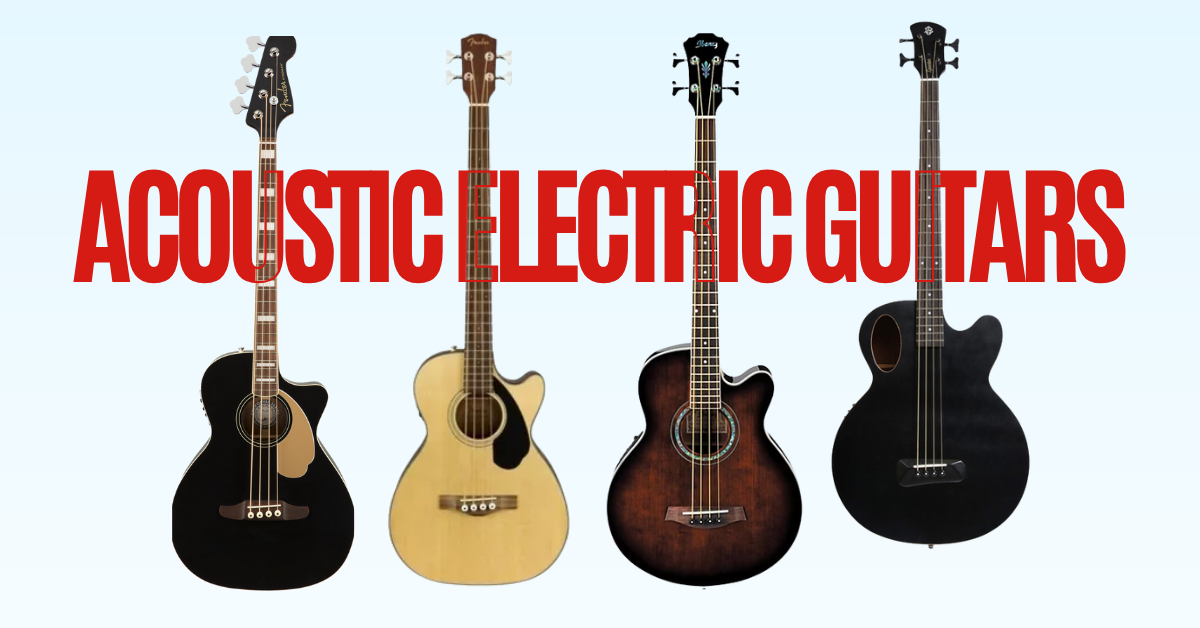If you’re looking for an acoustic guitar, the type you decide to spend your hard-earned dollars on will depend entirely on what you want to do with it. When it comes to making the right choice, we can help you with that!
If you just want to chill out in an armchair and strum away to your heart’s content, just picking the guitar up when the mood takes you, then a standard acoustic will do just fine. Similarly, for recording – perhaps in a home studio – you’ll get the best results with an acoustic guitar/condenser microphone combo.
But if busking’s your thing, or you want to use your acoustic live, then you really need an acoustic electric guitar which offers the best of both worlds.
We’ve broken this review down by price point: sub-$300, sub-$500 and sub-$1,000 to suit different wallet sizes. If money is no object though, our top pick (excuse the pun) is the Martin Road Series D-10E dreadnought but read on to find the best acoustic guitar for your particular needs.
Criteria
- Acoustic electric guitars have two primary functions in life: to sound decent unplugged and through an amplifier so that was a primary consideration
- We also paid close attention to the materials used and how that affects the sound
- Comfort was another priority because after all, guitarists come in different shapes and sizes
- And last but by no means least, the ever important preamps, pickups and tone controls that help shape the amplified sound
Best Acoustic Electric Guitar under $300
1. Category Winner: Fender FA125CE Dreadnought
Once upon a time at this price point, cheap and cheerful was probably the best you could hope for. Now, thankfully, those days are long gone and you really should expect a decent instrument for this kind of money.
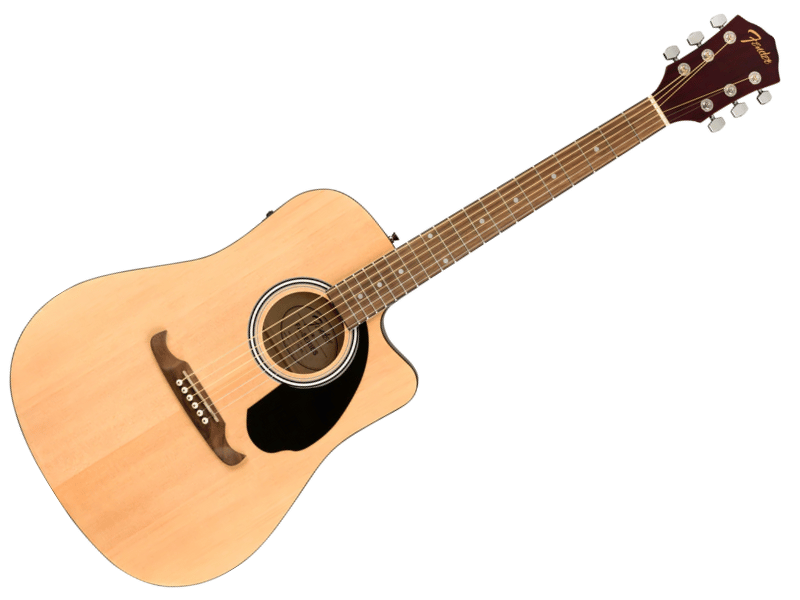
And with the Fender FA125CE acoustic electric guitar that’s exactly what you get.
This is a 25.3” scale length single cutaway dreadnought style guitar. Named after a style of battleship of all things, dreadnoughts are large bodied guitars that generally sound pretty loud unamplified with a deep, rich tone. It’s not rocket science: more wood = more sound.
Being single cutaway, the Fender FA125CE is ideal for players who like to indulge in lead work at the upper reaches of the fretboard – the cutaway gives you access to a few extra frets. If you tend to loiter down at the nut end of a guitar, this is less of a desirable feature.
The main drawback with cutaways is simply that by default you’re removing wood – and that means less bass.
Construction wise, for this money, the composition is predictably mainly laminate – thinly veneered layers of wood glued together – but worry not, it’s reassuringly solid and strong.
The Nato neck is comfortable and the tone is lively and bright with a decent bottom end. The 11.81” radiused fingerboard is smooth with no rough edges that could potentially damage a digit.
Whilst the Fender FA125CE is technically an entry-level guitar, intermediate players will also appreciate its playability and sound quality. Fishman electronics offer a built in tuner and volume, bass and treble controls for sound sculpturing when playing amplified.
The Good
- A well finished, nice guitar for the money
- Fishman electronics offer a wide range of sound shaping capabilities
- Excellent amplified sound
The Not so Good
- At this price point, there’s not much to dislike
- Sound quality is better amplified; a little thin unplugged
The Bottom Line
If you’re looking for a high quality entry-level acoustic electric guitar that will see you right for a good few years then you won’t go far wrong with the FA125CE. And it’s a Fender.
2. Gretsch Gin Rickey
Gretsch are one of those iconic guitar manufacturers. They’re best known for their legendary, instantly recognisable electric guitars – but they make excellent acoustics too.
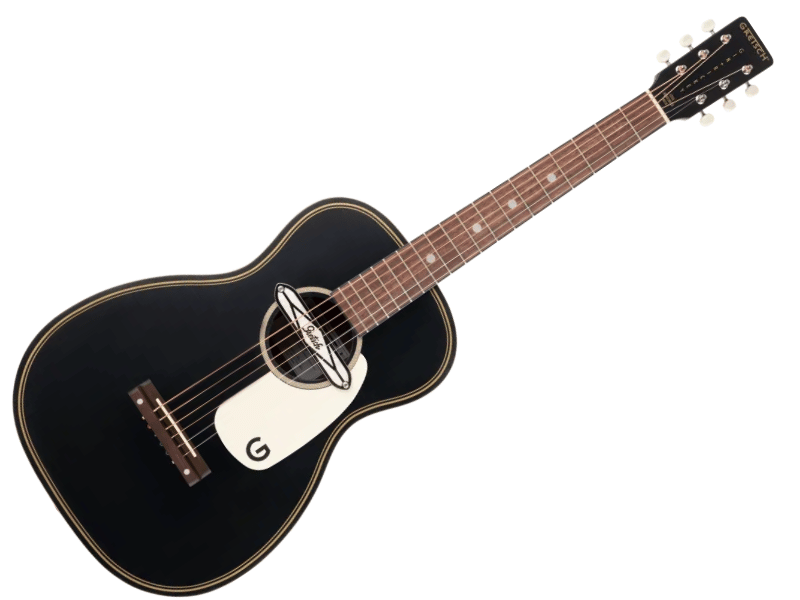
The Gretsch Gin Rickey is a ¾ sized parlor guitar – and it’s important to take that in for a second. You’re not going to get any full-bodied dreadnought tones out of this thing so if that’s what you’re after, look elsewhere. It has a 24” scale length and 18 frets. Basswood is used on its top, back and sides with a walnut-topped nato neck.
Need more info? Take a look at our Gretsch Gin Rickey in-depth product review.
But what Gretsch has aimed for with this guitar is recreating a vintage vibe from a bygone age. It’s utterly superb for banging out blues riffs and slide guitar. Its compact size means you can take it anywhere – or leave it lying around the house ready for you to grab when the creative juices start flowing.
This guitar encapsulates a specific period in time and with its Smokestack Black satin finish, aged white body binding, nickel hardware and vintage diecast tuners, it looks and sounds the part.
The jewel in the Gretsch Gin Rickey’s crown however is the Deltoluxe magnetic soundhole pickup. Acoustically, the guitar is distinctly mid-range and for its size, bass, treble and overall sound projection is decent.
But plug it in and this guitar really shines. Twangy bluesy tones ring out loud and clear and if slide guitar’s your thing, then you won’t be disappointed. Crank up the overdrive and you’re in blues crunch heaven!
The Good
- Looks and sounds great with a distinctly vintage vibe
- Acoustic it’s very good; amplified it’s really, really good
- The Deltoluxe soundhole pickup is the icing on the cake
- A lot of guitar for little money
- Unashamedly fun to play
The Not so Good
- We found the action to be a little high for general strumming and picking – but this turns into a positive for slide playing where a higher action often helps
- Quite narrow string spacing at the nut. Some may find this restricting
The Bottom Line
Because of its size, the Gretch Gin Rickey will suit younger players and those not endowed with large mitts but from a wider perspective, we think everyone should try one of these guitars.
Fantastically portable with a great vintage vibe and a range of awesome tones means you probably won’t want to put this down. Great value for money too.
3. Yamaha APX 600
The Yamaha APX 600 is a thin line, cutaway body acoustic electric guitar developed to replace the APX 500 which has been around forever. It boasts a spruce top, nato back and sides and a rosewood fingerboard.
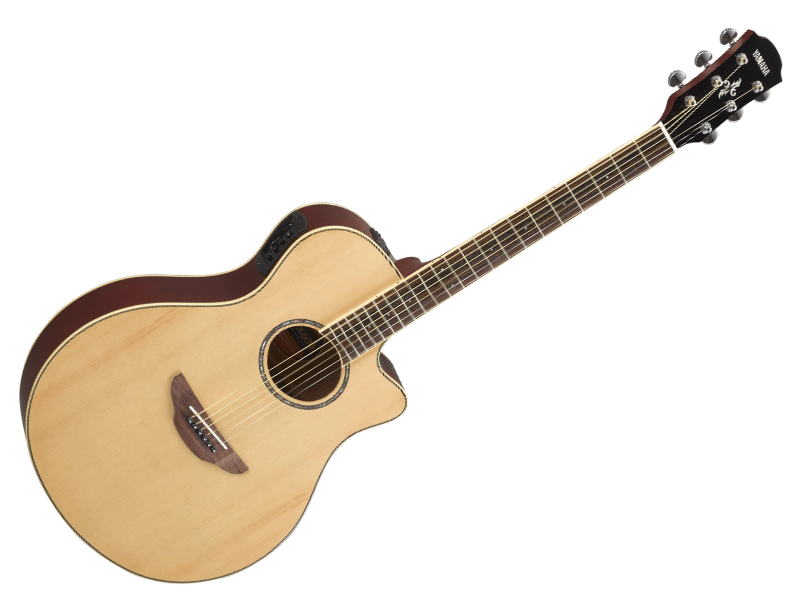
Compared to its predecessor, the new incarnation features a shorter 25” scale length (the APX 500 was 25.3/4”) and reduced string spacing making it very easy to play.
But that’s not the only enhancement: internally the bracing has been improved. This is the system of wooden struts that internally support and reinforce the soundboard and back of acoustic guitars. The APX 500 was definitely weak in the unamplified sound department but the APX600 is a marked improvement across the sound spectrum.
It’s no dreadnought but it’s pretty good.
Plug the APX 600 into an amplifier and the System65 preamp and SRT piezo pickup bring the guitar to life. The controls are very ‘musical’ comprising volume, 3-band EQ and a mid-frequency sweep. The now ubiquitous built-in tuner is a welcome addition.
The Good
- The electronics are powered by 2 x AA batteries. Much easier to source than 9v when your battery conks out just before a gig
- Excellent amplified sound
- 10mm string spacing is very comfortable
- Affordable
The Not so Good
- The supplied gig bag is next to useless. Replace it
- Sound not muted when using the tuner is on. Bit of a pain when playing live
The Bottom Line
You want an affordable quality acoustic electric guitar so let’s be honest, Yamaha don’t make bad guitars. It really excels when used amplified.
The Best Acoustic Electric Guitar under $500
1. Category Winner: Martin LX-1E Little Martin
While the 20 fret LX-1E is Martin’s smallest guitar, it’s a veritable monster on tone, quality and versatility. This is a little guitar with a big sound.
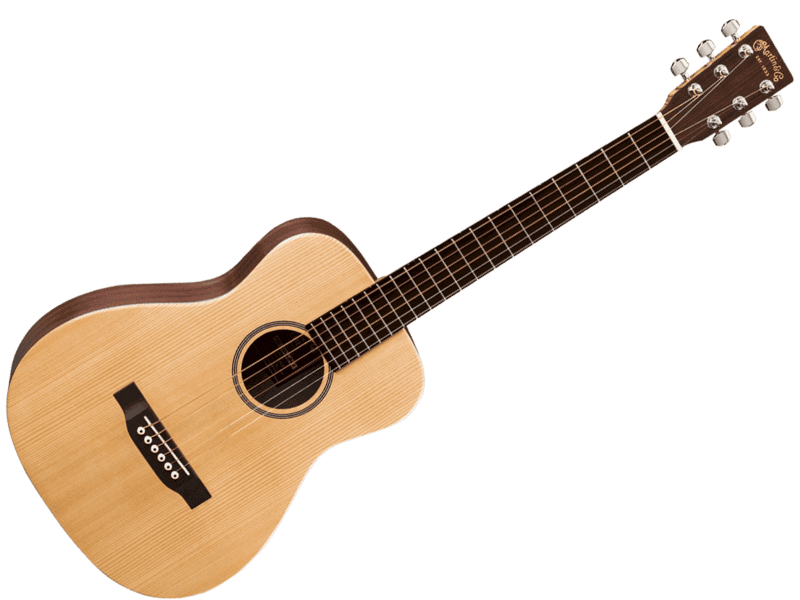
‘Parlor’ sized, it features a solid Sitka spruce top, X-brace bracing pattern, mahogany high-pressure laminate (HPL) back and sides, and a warm satin finish. It’s ideal for travel, playing around the house or campfire.
In fact, when designing this guitar, Martin obviously had traveling in mind. High pressure laminate is claimed by the company to be particularly effective for combatting temperature and humidity changes. If globetrotting is your thing, this can only be good although we were unable to verify this particular characteristic.
Neck material is rust birch laminate which is a dye impregnated wood veneer with excellent durability and strength and the fingerboard is Richlite – kind of a man-made ebony.
Despite its small size, the LX1E punches above its weight and packs impressive volume when played unamplified. It responds to being played hard. Plug it into an amp and the thing really sings. Bright and crisp but with a decent although understandably ‘restrained’ bottom end. Also nice for fingerpicking.
The LX-1E comes with very ‘musical’ electronics via courtesy of an Eq contour shaping control, volume control, and phase control. A chromatic tuner is also provided for good measure. Power is via a 5v battery which seems to last forever.
The Good
- Small enough for an aircraft cabin without getting arrested
- The provided soft gig bag is nice
- Stays in tune really well
- Second to none as a travel guitar
- Used by Ed Sheeran – which means you can check out how the guitar sounds for yourself
The Not so Good
- The small size will put some people off. It does look like a toy (until you play it)
- It’s a tad neck heavy which some players may find uncomfortable
- Body end strap button is fiddly to put a strap on – it’s too wide
The Bottom Line
Martin has managed to condense all their guitar manufacturing expertise into a small package with a sound that defies its size. If you can live with the fact that this looks a bit like a toy then you won’t go wrong with the LX-1E.
2. Fender CD-140SCE
Like Ibanez, Fender is much better known for its electric guitars: Stratocaster, Telecaster, Jaguar, Jazz, Precision – they’re all household names and deservedly so.

But Fender’s acoustics are well-made and great value for money. The CD-140SCE is a case in point. This 25.3” scale length cutaway, dreadnought style guitar is aimed at intermediate players and features a solid spruce top, rosewood back and sides, mahogany neck and a rosewood fingerboard with rolled edges to protect those delicate digits.
But that’s not all. Fender has used scalloped ‘X’ bracing in this guitar which is thinner than more conventional bracing and uses less wood. This in turn results in a reduction in soundboard mass which lets the spruce top resonate more freely. A deep rich sound and greater projection is the reward.
You won’t be disappointed with the amplified sound either. The Fishman Presys pickup system with active onboard preamp, tuner, volume and tone controls takes care of that.
The Good
- The solid spruce top is the jewel in the crown on this guitar producing excellent dynamic range, responsiveness and brightness
- There’s a hard case
- Sounds great unplugged or amplified
The Not so Good
- Hard to fault this guitar. Action was a bit high but we’d always recommend a set-up anyway
The Bottom Line
Fenders are legendary for their electrics but this could just be the guitar to make a sizeable meteoric dent in the acoustic electric market. This is a high quality guitar that would keep even relatively experienced guitarists happy. This is a very, very close second to the Martin.
3. Yamaha FSX830C
The Yamaha FSX830C is manufactured in China – but don’t let that put you off.
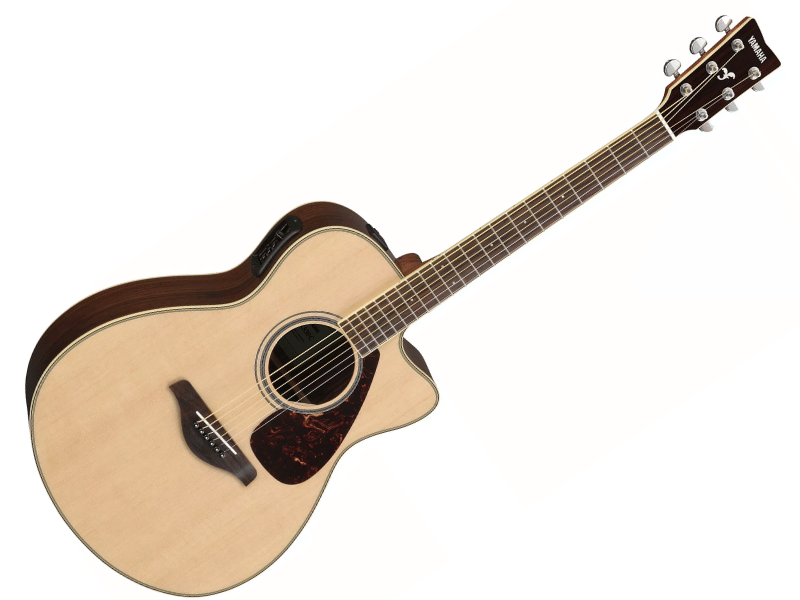
Building on Yamaha’s legendary FG series of solid top dreadnoughts, which has been around for half a century now, the FSX830C is its altogether smaller, shorter scale concert sized sibling with a scale length of 25” compared to the FGs 25.6”. A single cutaway facilitates easy access to the upper reaches of the rosewood fingerboard.
A solid top is always a good feature in terms of sound projection and overall tone and spruce is the wood of choice here with rosewood back and sides. The result is a full bodied sound – aided also by Yamaha’s scalloped bracing which also boosts volume when played acoustically – especially in the low and mid-range areas.
Again, don’t expect dreadnought-esque volumes but then why would you? This is an altogether smaller guitar. Amplified, Yamaha’s system66 + SRT (studio response technology) + piezo pickup really does the business.
Controls include: volume/3-band EQ/tuner/adjustable mid-range frequency control (from 80-10kHz) powered by an AA battery offering a myriad of sound tweaking options.
Because of its somewhat bijou vital statistics, the FSX 830C will appeal to smaller players and anyone else for that matter that doesn’t relish the idea of wrestling with a dreadnought. Its versatility means it ticks boxes for beginners and intermediate players not to mention the odd virtuoso here and there.
The Good
- High quality woods mean this is a full bodied sounding guitar
- Yamaha’s SRT (studio response technology) is excellent. Tonally, it captures the full unique character of the a guitar and simply
- projects that sound as if the guitar was mic’ed up
The Not so Good
- Neck may be too narrow for sausage fingers
- No pegs to hang the shoulder strap. If you want to play standing up you’ll need to attach a strap to the headstock
- The onboard tuner doesn’t mute the output
The Bottom Line
A smaller bodied guitar that tries hard to compete with a dreadnought and does a pretty good job. We like the woods used in the construction and also the SRT electronics which maintains the character of the guitar when amplified.
Best Acoustic Electric Guitar under $1,000
1. Category and Overall Winner: Martin Road Series D-10E dreadnought
Truth is, in this category, all three guitars are winners, but by a gnat’s whisker the Martin D-10E dreadnought has edged its way to the top of the pile across all the price point categories. Actually, this is Martin’s lowest priced solid wood (top, sides, back) guitar.

The build quality on the D-10E is exemplary. Constructed with a Sitka Spruce top and Sapele back and sides, the guitar exhibits excellent sustain, depth of sound and clarity. The Richlite fingerboard – a mega hard solid paper composite – is as smooth as a cashmere codpiece!
The D-10E actually replaces the insanely popular DRS1 and DRS2 models and introduces welcome improvements in terms of aesthetics and electronics. The former sees the introduction of a mother of pearl pattern fingerboard; mother of pearl soundhole inlay, faux tortoiseshell pickguard; and rosette inlay with multi-stripe rosette border.
Regarding electronics, the D-10E comes complete with Fishman MX-T package. Here you get volume and tone controls and an inbuilt tuner. What’s unusual is the fact that the controls for both are located inside the soundhole rather than on the top of the body which is the usual location. Basic springs to mind but they do the job. The tuner is a nice addition as it’s discreet and backlit.
Unplugged the guitar sounds awesome. Amplified the Fishman electronics do a decent job but for really serious sound-shaping tonally, be prepared to make tweaks on your amp or mixer. Also thrown in for good measure is a really nice, high quality padded case with twin shoulder straps. It’ll keep your pride and joy well protected on your travels.
The Good
- Excellent craftsmanship and choice of woods. Lovely satin finish
- Supplied with a really nice Martin case
- The tuner is a nice addition
- We love the sound: heavy and snappy with a rich bass tone without being muddy. Good sound projection
- Great for chord thrashing but equally desirable for fingerpickers
The Not so Good
- Limited tone controls
- Some players may not be struck on the ‘in-soundhole’ electronics
- Not specific to the D-10E but solid woods are more susceptible to temperature fluctuations
The Bottom Line
Comparatively speaking, the Road Series Martins do a great job of capturing the famous Martin tone for not a lot of money. And you get a really nice Martin case. Price aside, the Martin D-10E is the best sounding acoustic electric guitar in our review. Read our full product review here.
2. Seagull Maritime SWS Burnt Umber GT QIT
No prizes for guessing the color of this guitar, but to decipher the rest of the nomenclature, SWS stands for solid wood series; GT is an acronym for Gloss Top and QIT is short for Quantum IT – the Godin-developed volume/treble/bass transducer system used on this guitar.

As with all Seagull SWS models this is an all solid wood, non-cutaway dreadnought style guitar with a ‘select pressure tested’ solid spruce top and solid mahogany back and sides.
Now what ‘select pressure tested’ actually means exactly, who knows, but Godin (Seagull’s parent company) adopts this method as a way of determining the overall strength of the spruce top prior to build.
Pressure is applied to each potential top to establish whether it can achieve a predetermined fixed level of deflection. The more pressure necessary, the stronger the top. Anything falling short is rejected.
Sounds like good old fashioned quality assurance to us mixed in with a modicum of marketing hype but the true test is with the sound – and that’s something Seagull definitely has got right.
It’s full, deep, rich and loud. A great sounding guitar both unplugged and amplified – and with its gloss top and semi-gloss satin back and sides, it looks stunning.
Amplified and with the Quantum IT system set flat the guitar sounds excellent but for fine tuning tonally – particularly in a live environment, the Eq controls can really help you cut through. There’s a built-in tuner too with auto shut-off.
The Good
- Visually highly desirable. Solid wood means a great sounding guitar – and it’ll get better with age
- Hard case included
- Rock solid tuning. Seagull’s ‘bullet’ headstock ensures an optimally straight string path to the tuners
The Not so Good
- There’s little to criticize. It has a substantially solid neck which may not suit all players – but we’re nitpicking
The Bottom Line
There’s a lot to like about this guitar. Being a dreadnought the sound is full and loud but the Maritime SWS is just fun to play and looks fantastic. It’s just one of those guitars that makes you want to push your playing to the next level.
3. Takamine GD93-NAT Dreadnought
At this price point with acoustic electric guitars, it’s not unreasonable to expect an all wood construction so the Takamine GD93CE-NAT (natural finish), with its solid spruce top, black walnut/maple sides and jaw dropping three piece black walnut/maple back with triangular strip was a sight to behold.
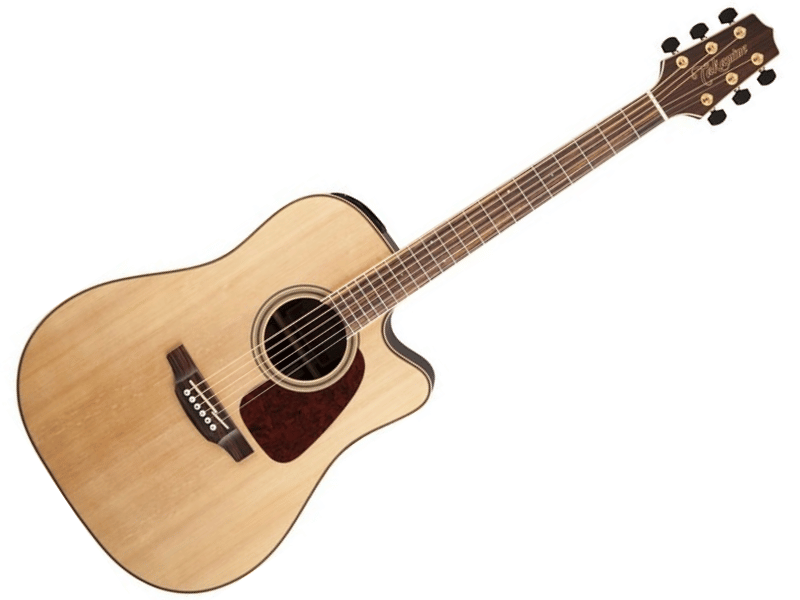
This is a single cutaway dreadnought with a slim mahogany neck and 12” radius bound laurel fingerboard providing great feel and playability. It sounds loud and vibrant unamplified as you would expect with an all wood construction – and these qualities that are retained when plugged into an amp.
The onboard 9v battery powered Takamine TK-40D preamp system gives you a built-in tuner, three-band EQ and gain controls, mid contour switch, notch filter and EQ bypass switch for versatility and sound quality. The controls are positioned higher up than on most other guitars, much closer to the neck. Takamine says they’re much more accessible in this position. We’re not so sure.
It’s always reassuring when renowned artists favor a brand and Takamine acoustic electric guitars not short of an endorsee or two. Take your pick from Jon Bon Jovi; Steven Wilson; Biffy Clyro’s Simon Neil; Garth Brooks; Bruce Springsteen; and Don Henley.
Takamine has been making guitar for 60 years beginning life as a family run guitar shop in 1959 at the foot of Mount Takamine in the Japanese town of Sakashita. It knows a thing or two about quality – for example the company uses a laser guided fret finishing system that levels and crowns each fret to within 0.0001”.
For excellent craftsmanship, sound quality and value for money, Takamines are hard to beat. The GD93CE competes with anything in its class.
The Good
- Excellent craftsmanship and choice of woods
- Really loud sound projection when used unplugged
- Highly functional Eq system
- Good set up straight out of the box. Takamine’s distinctive split-saddle bridge provides accurate acoustic intonation
The Not so Good
- It’s hard to find fault with this guitar. The positioning of the preamp system is a little unorthodox
- No case supplied
The Bottom Line
The GD93CE-NAT is just a really nice, high quality instrument that sounds superb unplugged or amplified. Comfort is high on the agenda – the ‘C’ shape neck features an ergonomic contour slightly thinner on the bass side so that it fits the natural shape of your hand. Highly recommended.
The Verdict
This review ably demonstrates that whatever your budget, you can get your mitts on a well-made, decent acoustic electric guitar straight off the shelf. The hottest contested price bracket however was the sub-$1,000 category. The Martin D-10E lunged at the finish tape and won by a smidgen but it has to be said that the Seagull and Takamine guitars were worthy runners-up.

